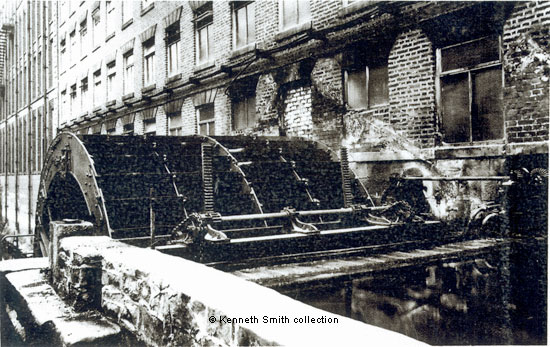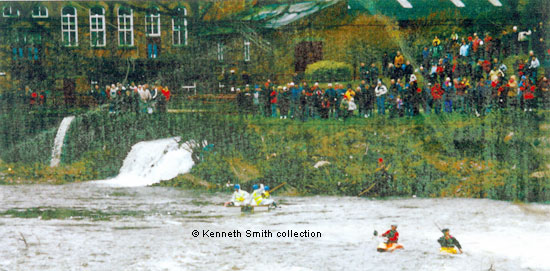|
Images Index> Matlock Bath, 20th and 21st Century Images> This page |
| Matlock Bath: Masson Mill's Water Wheel, about 1930 |
| Matlock Bath : Twentieth Century Photographs, Postcards, Engravings & Etchings |
|
|||
On close examination it becomes obvious that the wheel has been repaired. For example, there are a couple of straps over a noticeable crack in the casing to the right of the lettering and partly obliterating it. In fact the wheel is rather a hotchpotch at this stage in its life; the two main spokes being of different construction, one being part of the original casting, the other bolted to the hub; the smaller spokes are not spaced evenly around the rim as one might expect; and no two spokes are fixed identically to the rim. In the centre foreground we can see the outer end of the wheel's shaft in its bearing. The shaft would have passed through the wall to drive the machinery inside the mill building.
It also shows us that this was an undershot wheel, with the water entering from the right and then dropping down to a lower level on the far side of the wheel. We know from various drowning accidents that a grid or grating was fitted just in front of the water-wheel to prevent river-borne debris - or people - from getting into the mechanism ("the wheel is guarded by iron fixtures")[4]. This photo also provides us with clues about how the wheel worked. On this side of the wheel there are control rods which regulated the rise and fall of the sluice gates. The two vertical bars would have been attached to the sluice gates in the water below, which would have been raised or lowered by the rotation of the chain driven operating mechanism. We can see chains on either end of the long rod. About half way up the picture, on the far right, is another rod, likely to have been part of the gearing arrangement and connected to a hand-wheel inside the building to control the speed of the wheel. In December 1928 it was reported that "Masson Mills ... are contemplating considerable alterations and extensions to their premises"[5] and in September 1930 that "the engineering department of the English Sewing Cotton Company are introducing turbine water power at Masson Mills, Matlock, harnessing the River Derwent[6]. Unfortunately for the mill and its workers, the following year 300 workers had to sign on at the Employment Exchange as the sluice which worked the turbines was completely wrecked by flooding[7]. Flooding wasn't new and in 1890 the water wheel had been unable to be used because of floods with, unfortunately, 300 or 400 hands thrown temporarily out of employment[8]. Joseph Warburton, who was born at Elton, Bury, was the manager of the Masson Mills for eight years. During his time at Matlock Bath he took a great interest in the public life of the village, and especially in the welfare of his employees. Whilst he was the mill's manager a large canteen and welfare hall was erected for the benefit of the workers, the mill was considerably enlarged and a new wing added[9]. He and his family lived at Highfield[10]. He retired in 1932 owing to ill health and died at Blackpool on 13 March 1934, aged 56[11]. One of his daughters, Jessie Warburton, remained in Matlock Bath for some years[9]. Both Highfield on Guilderoy Road (Upperwood Road) and Glenside on Clifton Road clearly belonged to the mill as in 1937 the English Sewing Cotton Company of Manchester offered both properties for sale[12]. The former became the home of the Aspey family whilst Glenside was owned by the web mistress's mother (Mrs. Clay) in the 1950s.
|
|||
1, 2 and 3. All images © Kenneth Smith collection. Information researched, written by and © Ann Andrews. With input from Andy Andrews about the wheel gratefully added. Intended for personal use only. |
|||
|
[1] Wren and Bennet were producing machinery at the time of Chartism in the U.K. when there were petitions and riots over suffrage for men, secret ballots, etc. One reference to the firm dates from 1842 and was published in the "Taunton Courier and Western Advertiser", 24 August 1842. "Manchester, --- and Millwrights, Newton Street ... consequence of the hands being either ----d or privately intimidated from continuing at labour. This establishment of Messrs. Wren and Bennet, tenters and millwrights, Newton-street, who recommenced working this morning. During the forenoon about 100 mechanics and millwrights went up the street, and one or two of them asked to speak with one of the hands. A short conference took place and shortly afterwards most of the hands left the works". Not easy times for workers. The Wren and Bennet partnership was dissolved a few years later. [2] From: "The Derwent Valley & Its Mills" and other sources. [3] "Derbyshire Advertiser and Journal", 9 May 1890. Whether the paper thought this wheel had been at Masson Mill since Arkwright built it is unclear. [4] "Nottinghamshire Guardian", 13 August 1892 and quote from "Derbyshire Advertiser and Journal", 19 August 1892. [5] "Derbyshire Times", 29 December 1928. [6] Whilst it is generally thought that the turbines were installed at Masson Mill in 1928, the only newspaper reference to the installation of turbines was published in the Hull Daily Mail, 30 September 1930 which is quoted above. It refers to the turbines being introduced as opposed to them having been installed. [7] Reports on the 1931 flooding from "Derby Daily Telegraph", 7 September 1931 and "Nottingham Evening Post", 7 September 1931. [8] "Derbyshire Courier", 25 November 1890. [9] Obituary notice, Derby Daily Telegraph, 15 March 1934. Death of Mr. J. Warburton. Public Work. Matlock Bath. [10] Joseph Warburton is shown at Highfield, Guilderoy Road in Kelly's 1925 Directory and Kelly's 1928 Directory. In the 1911 census he was living at Swinton and employed as a Cotton Weaver's Mill Foreman. [11] Will calendars on the GOV.UK, Wills, probate and inheritance web site. [12] The "semi-detached villa
residence",
known as "Highfield", Holme Road was first advertised
by Manchester solicitors in 1935 (Derbyshire Times,
18 January 1935) and in 1937 the Glenside was also included
with both being sold on behalf of the English Sewing Cotton
Company via the Matlock auctioneer Marchant Brooks (Derbyshire
Times, 17 September 1937). |









